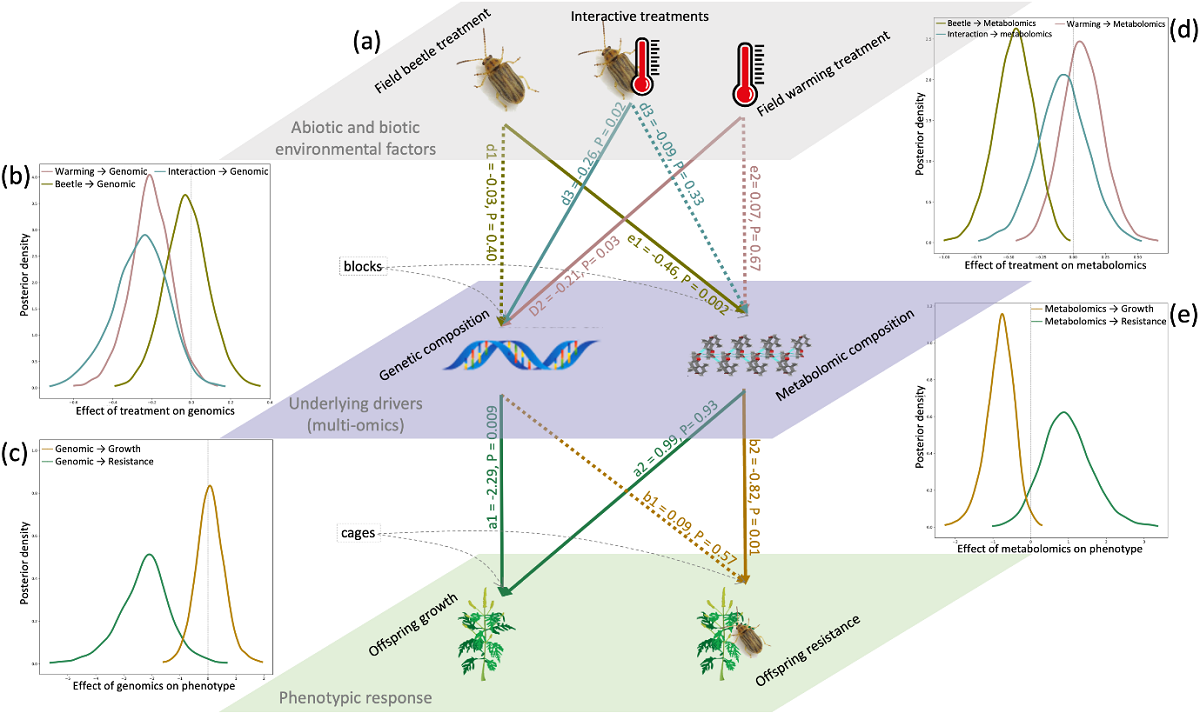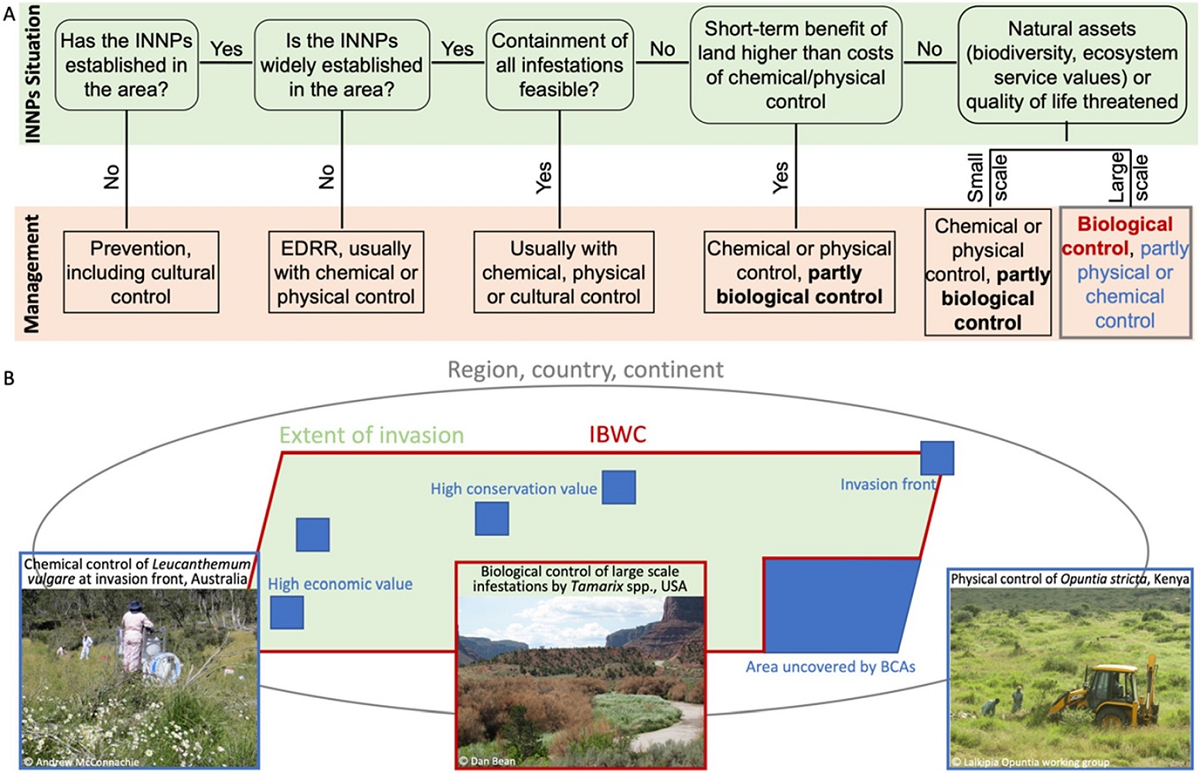南湖新闻网讯(通讯员 孙燕)近日,我校资源与环境学院孙燕教授的研究成果以“Climate warming can reduce biocontrol efficacy and promote plant invasion due to both genetic and transient metabolomic changes”为题在Ecology Letters发表,研究揭示了气候变化下入侵植物天敌防御策略的潜在分子遗传机制和代谢可塑性机理。
气候变暖下,生物入侵日益加剧,外来入侵草害已对全球生态环境安全构成严重威胁。因此,气候变化下的入侵植物防治是当前全球共同面临的一项重大挑战。豚草(Ambrosia artemisiifolia L.)原产于北美洲,为一年生草本植物。据统计,豚草对我国农林渔业每年造成的直接经济损失高达十多亿元,而豚草花粉过敏产生的医疗费用高达14.5亿元。我国科学家利用入侵植物豚草的外来天敌豚草条纹萤叶甲,成功地控制了入侵杂草豚草的种群密度,成为生物防治成功的经典案例。然而,气候变化下入侵植物防御生防天敌昆虫的生态进化机制尚不清楚。
孙燕教授以入侵植物豚草及其生物防治天敌昆虫豚草条纹萤叶甲为研究对象,解析了气候变暖下入侵豚草响应生防天敌取食的分子机制,发现气候变暖导致入侵豚草种群母代与子代在基因型组成上存在显著差异;与对照组子代相比,气候变暖下入侵豚草子代种群具有显著的遗传变异,且各子代种群进化方向趋于一致,表现出更高的生长和繁殖能力。而生防天敌取食会导致入侵豚草母代与子代在代谢组成上发生明显差异;与对照组子代相比,天敌取食下入侵豚草后代种群显著提高了次生代谢产物的分泌,表现出更高的防御性。利用贝叶斯层级模型整合豚草的基因组、代谢组和表型组数据,结果显示,在当地气候条件下,入侵豚草后代通过提高次生代谢产物的分泌来防御天敌,但是其生长受到抑制,表明其在防御性和入侵性上存在权衡关系;而在升温条件下,入侵豚草会通过遗传变异来提高后代的生长性状,其后代利用代谢可塑性提升防御豚草条纹萤叶甲的能力,说明其防御策略调整和入侵性状改变存在同步关系,气候变暖减弱了入侵豚草的生物防治效果,加剧入侵(图1)。本研究为全球变暖背景下入侵植物的生物防治提供了重要的理论依据。

图1 贝叶斯层级模型整合基因组、代谢组和表型组数据

图2 决策树法分析杂草生物防治
基于上述研究成果,孙燕教授在国际学术期刊Biological Conservation在线发表了题为“Fighting neobiota with neobiota: Consider it more often and do it more rigorously”的前瞻性文章,介绍了生物防治入侵豚草的成功案例及其对生态环境安全与人类健康的积极影响,总结了入侵植物的生物防治理念、关键技术和发展历程,提出了运用决策树法评估杂草生物防治的作用和效果,提议杂草生物防治的支持者和反对者沟通合作为杂草绿色防治提供更优的解决方案(图2)。
华中农业大学资源与环境学院孙燕教授是Ecology Letters文章的第一作者和唯一通讯作者;是Biological Conservation文章的第一作者。上述项目受到华中农业大学高层次人才启动经费和“武汉英才”项目的资助。
【英文摘要】
(发表于Ecology Letters论文)
Climate change may affect plant–herbivore interactions and their associated ecosystem functions. In an experimental evolution approach, we subjected replicated populations of the invasive Ambrosia artemisiifolia to a combination of simulated warming and herbivory by a potential biocontrol beetle. We tracked genomic and metabolomic changes across generations in field populations and assessed plant offspring phenotypes in a common environment. Using an integrated Bayesian model, we show that increased offspring biomass in response to warming arose through changes in the genetic composition of populations. In contrast, increased resistance to herbivory arose through a shift in plant metabolomic profiles without genetic changes, most likely by transgenerational induction of defences. Importantly, while increased resistance was costly at ambient temperatures, warming removed this constraint and favoured both vigorous and better defended plants under biocontrol. Climate warming may thus decrease biocontrol efficiency and promote Ambrosia invasion, with potentially serious economic and health consequences.
论文链接:https://doi.org/10.1111/ele.14000
(发表于Biological Conservation论文)
Invasive non-native plants (INNP) cause severe impacts on nature and human well-being, and these are predicted to increase. While management tools have been developed to control early-stage invasions or to clean particular sites from INNP, they are only rarely available to halt and reduce large-scale invasions. Importation biological weed control (IBWC; also termed classical biological weed control) offers a potentially effective tool, especially when combined with other land management interventions. Here, we aim to bridge the gap between IBWC advocates and critics by providing a state of the art of IBWC and exploring untapped opportunities and new ideas to further increase efficacy and safety of this tool. We first present a decision tree to identify the circumstances under which IBWC should be considered, either alone or as part of an integrated weed management approach. We then address concerns raised against IBWC by contrasting historical approaches with recently suggested improvements and outline a path forward. With two case studies, we emphasize that successful reduction of weed densities using IBWC will specifically also contribute to environmental health and human well-being by restoring ecosystem services without pesticide input and reaching areas with otherwise no INNP management options. We hope that our compilation helps to reconcile advocates and critics of IBWC and lead to a more constructive discourse and hopefully closer collaboration between the two groups. A joint effort is needed to further improve IBWC and to consider it more often, as the increasing threats imposed by INNP are urgently awaiting sustainable and affordable solutions.
论文链接:https://doi.org/10.1016/j.biocon.2022.109506
审核人:熊海林

